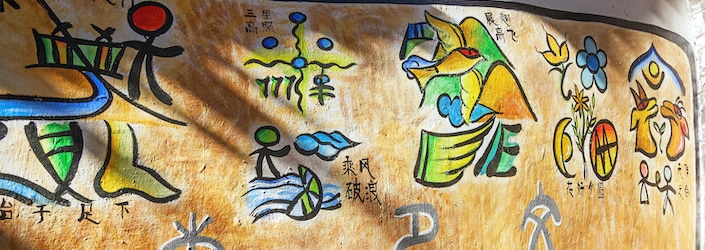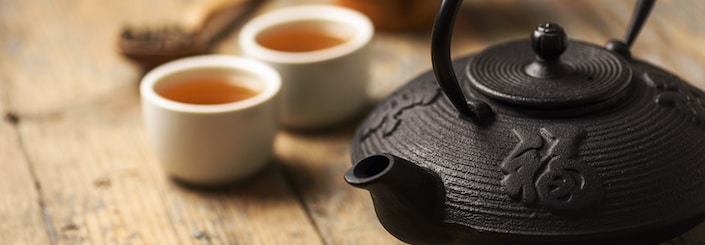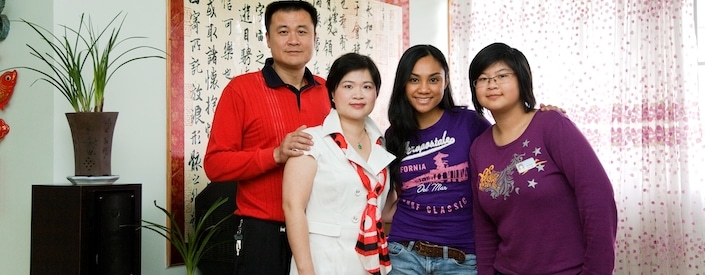

中国一共有56个民族,除汉族以外的其余55个法定民族都是少数民族。55个少数民族中,除回族已全部使用汉语外,其他54个民族都有自己的语言。随着中国现代化进程的加快,一些少数民族语言正在慢慢消亡。尽管中国在少数民族语言保护方面已经取得一定的成绩,但仍然还有很长的路要走。
云南是中国少数民族最多的省,56个民族中,云南就有52个,其中人口在5000人以上的民族有26个,除汉族外,少数民族有25个。这其中最值得了解的民族就是白族与纳西族。
白语是白族的民族共同语。白族的服饰有一个漫长的历史发展过程,并形成了自己的民族特色。白族人喜爱白色,尽管各地服饰稍有不同,但是都以白色衣服为贵。白族以雕刻艺术著名,尤其是石雕与木雕。北京人民大会堂云南厅也使用了白族的木雕。
纳西族主要居住在云南丽江市,是一个古老的民族,以纳西语为民族语言。他们的文字是云南最古老的少数民族象形文字,也就是东巴文,已有上千年历史,是世界上仅存的象形文字。因此,引起了世界各国学者的极大关注与重视。
纳西族除了春节以外,最重要的节日就是火把节。每年农历六月二十四日起,到农历六月二十七日结束。期间家家户户点火把,由年轻人拿着火把在田边、山路上边走边唱,一直到深夜,表示对火神的尊敬,并希望过上美好的生活。
| 白族 | Báizú | the Bai ethnic group |
| 纳西族 | Nàxīzú | the Naxi ethnic group |
| 东巴文 | Dōngbāwén | Dongba writing (the picto-ideographic writing used by the Naxi ethnic group) |
| 火把节 | Huǒbǎjié | Torchlight Festival (traditional festival celebrated by several Chinese ethnic groups) |
| 火神 | Huǒshén | God of Fire |
| 人民大会堂 | Rénmín Dàhuìtáng | The Great Hall of the People in Beijing |
| 确认 | quèrèn | to confirm |
| 取得 | qǔdé | to obtain |
| 值得 | zhíde | to be worth it; to be worth doing something |
| 使用 | shǐyòng | to use |
| 引起 | yǐnqǐ | to cause; to lead to |
| 关注 | guānzhù | pay attention to |
| 重视 | zhòngshì | place importance on |
| 表示 | biǎoshì | to show; to demonstrate |
| 现代化 | xiàndàihuà | to modernize |
| 消亡 | xiāowáng | to die out |
| 存 | cún | to exist; to deposit (money or an item) |
| 尊敬 | zūnjìng | to respect |
随着 (suízhe) is a preposition used to show that one thing is happening alongside or as a result of something else. This passage contains an example of its use as part of the following two-part structure:
随着中国现代化进程的加快,一些少数民族语言正在慢慢消亡。
Suízhe Zhōngguó xiàndàihuà jìnchéng de jiākuài, yīxiē shǎoshù mínzú yǔyán zhèngzài mànman xiāowáng.
In the wake of China’s increasingly fast-paced modernization, some minority languages are gradually disappearing.
In the above example, 随着 (suízhe) follows this structure:
随着 + general trend + subject + predicate
(A ‘predicate’ is the part of a sentence that contains a verb and tells us something about the subject.)
In our example, we have:
随着 (suízhe) + 中国现代进程的加快 (general trend) + 一些少数民族语言 (subject) + 正在慢慢消亡 (predicate)
When used as part of this structure, 随着 (suízhe) helps to indicate that the change mentioned in the introductory clause causes the change mentioned in the main clause.
随着中国现代化进程的加快 (introductory clause), 一些少数民族语言正在慢慢消亡 (main clause)。
In this two-part structure, the “general trend” that comes immediately after 随着 often has to do with social or economic trends, like economic development or a social phenomenon. Let’s look at our example again:
In our example, 随着 (suízhe) opens the sentence, which is usually—but not always—the case. Then, the general trend of China’s rapid modernization is introduced (现代化进程的加快). Next we have a main clause with the subject, “some minority languages” (一些少数民族语言) and predicate, “gradually disappearing” (正在慢慢消亡) that describe the result of this trend.
By using 随着 (suízhe) in this sentence, the author is indicating that the general trend of China’s modernization and the disappearance of minority languages are connected, and that modernization is causing languages to gradually disappear.
Here’s another example:
随着年龄的增长,人们会越来越重视健康。
Suízhe niánlíng de zēngzhǎng, rénmen huì yuèláiyuè zhòngshì jiànkāng.
As they age, people pay more and more attention to their health.
Here, 随着 (suízhe) comes first again, followed by a general trend, which in this case is aging. After the introductory clause comes the subject, “people” (人们 rénmen), followed by the predicate, “pay more and more attention to their health” (会越来越重视健康 huì yuèláiyuè zhòngshì jiànkāng).
The use of 随着 (suízhe) in this sentence indicates that the author believes that the general trend of aging causes people to pay more attention to their health.
Can you come up with two example sentences using 随着?
Like 随着, 尽管…但是 (jǐnguǎn…dànshì) tends to occur in sentences containing both an introductory and a main clause.
尽管 (jǐnguǎn) is usually (but not always) placed at the beginning of the introductory clause. It introduces some sort of background information that sets the scene for whatever assertion the author makes in the main clause.
Then, 但是 (dànshì) begins the main clause by introducing a fact or assertion that usually contrasts with the background information in the introductory clause.
尽管…但是 (jǐnguǎn…dànshì) appears in the following sentence:
白族人喜爱白色,尽管各地服饰稍有不同,但是都以白色衣服为贵。
Báizúrén xǐ’ài báisè, jǐnguǎn gèdì fúshì shāo yǒu bùtóng, dànshì dōu yǐ báisè yīfú wéi guì.
Bai people like the color white, and even though there are some regional variations among Bai clothing styles, white is highly prized by them all.
Here, 尽管 (jǐnguǎn) introduces some background information (the fact that there is some regional variation among Bai clothing styles). Then, the main clause starting with 但 (dàn) sets up a contrast, explaining that despite the fact that regional variations exist, all Bai groups favor the color white.
Note that although the English word “but” is not included at the beginning of the main clause when the introductory clause contains “even though,” 但 (dàn) or 但是 (dànshì) is often included as part of this construction in Chinese. Adding 但是 (dànshì) may seem odd if you’re a native English speaker, but you’ll soon get used to it.
Let’s look at another example:
我姐姐很爱工作,尽管腿受伤了,但她还是坚持去上班了。
Wǒ jiějiě hěn ài gōngzuò, jǐnguǎn tuǐ shòushāngle, dàn tā háishì jiānchí qù shàngbānle.
My sister really loves her job; even though she hurt her leg, she still insists on going to work.
In this sentence, 尽管 (jǐnɡuǎn) appears in the introductory clause to introduce some background information (the fact that the speaker’s sister hurt her leg).
Then comes the main clause, starting with 但 (dàn), the shortened form of 但是 (dànshì). In the main clause, the author introduces a fact that contrasts with the background already introduced regarding the sister’s injury. Even though the sister is hurt, she continues to work.
以…为… (yǐ…wéi…) is a relatively formal grammatical construction that has its roots in classical Chinese. It follows the pattern 以 + A + 为 + B and is used to express “to take A as B,” “to regard A as B” or “to consider A as B.”
Although sometimes heard in spoken Chinese, it is more common to see this structure being used in things like official government reports.
Unsurprisingly, since this structure comes from classical Chinese, it can also be found in many four character Chinese idioms such as 以人为本 (yǐrénwéiběn, to put people first; people-oriented).
The construction appears in the following sentence:
白族人喜爱白色,尽管各地服饰稍有不同,但都以白色衣服为贵。
Báizúrén xǐ’ài báisè, jǐnguǎn gèdì fúshì shāo yǒu bùtóng, dàn dōu yǐ báisè yīfú wéi guì.
Bai people like the color white, and even though there are some regional variations among Bai clothing styles, white is highly prized by them all.
If we consider the phrase 以白色衣服为贵 (yǐ báisè yīfú wéi guì) from the vantage point of the 以 + A + 为 + B structure discussed above, then 白色的衣服 (báisè yīfú, white clothing) is A, while 贵 (guì, valuable; prized) is B. Thus, we could translate this phrase literally as “to regard white clothing as valuable.”
Let’s look at another example:
大部分中国人都以米饭为主食。
Dà bùfèn Zhōngguó rén dōu yǐ mǐfàn wéi zhǔshí.
Most Chinese people regard rice as their staple food.
中国一共有56个民族,除汉族以外的其余55个法定民族都是少数民族。55个少数民族中,除回族已全部使用汉语外,其他54个民族都有自己的语言。随着中国现代化进程的加快,一些少数民族语言正在慢慢消亡。尽管中国在少数民族语言保护方面已经取得一定的成绩,但仍然还有很长的路要走。
云南是中国少数民族最多的省,56个民族中,云南就有52个,其中人口在5000人以上的民族有26个,除汉族外,少数民族有25个。这其中最值得了解的民族就是白族与纳西族。
白语是白族的民族共同语。白族的服饰有一个漫长的历史发展过程,并形成了自己的民族特色。白族人喜爱白色,尽管各地服饰稍有不同,但是都以白色衣服为贵。白族以雕刻艺术著名,尤其是石雕与木雕。北京人民大会堂云南厅也使用了白族的木雕。
纳西族主要居住在云南丽江市,是一个古老的民族,以纳西语为民族语言。他们的文字是云南最古老的少数民族象形文字,也就是东巴文,已有上千年历史,是世界上仅存的象形文字。因此,引起了世界各国学者的极大关注与重视。
纳西族除了春节以外,最重要的节日就是火把节。每年农历六月二十四日起,到农历六月二十七日结束。期间家家户户点火把,由年轻人拿着火把在田边、山路上边走边唱,一直到深夜,表示对火神的尊敬,并希望过上美好的生活。
 HSK 1 | My Dad Loves Drinking Tea
HSK 1 | My Dad Loves Drinking Tea
 HSK 1 | My Family's Dog
HSK 1 | My Family's Dog
 HSK 2 | My Bus Driver, Mr. Liu
HSK 2 | My Bus Driver, Mr. Liu
 HSK 2 | My Chinese Homestay Family
HSK 2 | My Chinese Homestay Family
